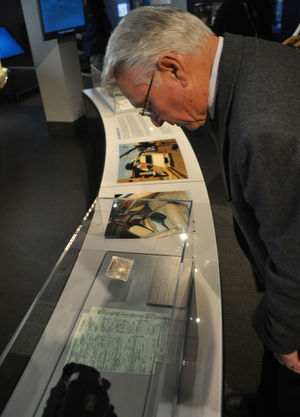Mark Schlachtenhaufen The Edmond Sun
OKLAHOMA CITY — “I like it,” Lucas Maddox, 12, said when asked how he feels about one of the new interactive exhibits at the Oklahoma City National Memorial and Museum. “But why did he do it?”
Lucas and his mother, Amy Maddox, a member of the team that designed the renovations, were sitting as they manipulated the images and information on the color, flatscreen TV-sized screen in front of them.

Edmond Police Chief Bob Ricks and one of the new exhibits at the Oklahoma City National Memorial Museum. Ricks was serving as the special agent in charge of the FBI’s Oklahoma City field office on April 19, 1995, the day of the bombing. Photo – Mark Schlachtenhaufen for The Edmond Sun
A moment later, information appeared on the screen giving the inquisitive youngster the answer.
Lucas listened while his mother told him how Timothy McVeigh was apparently motivated to act in Oklahoma City by his extreme anti-government anger over the deaths that occurred during FBI operations on the Branch Davidian compound in 1993 in Waco, Texas.
On Thursday, supporters of all sorts gathered at the museum to celebrate the end of the indoor work and to talk about the changes and plans for the 20th anniversary of the April 19, 1995, bombing of the Alfred P. Murrah Federal Building in downtown Oklahoma City.
Thirty-five new interactives including the FBI investigation, first responders and journalists along with the Survivors Object Theater and a new recently produced orientation video hosted by Oklahoma actor-singer Kristin Chenoweth — part of $10 million worth of upgrades — are ready.
Never-before-seen artifacts include the 15-foot-high sign from the Dreamland Motel, where McVeigh paid for a room, and the missile that cleared the Murrah building as recovery efforts were underway.
On the morning of April 19, 1995, McVeigh parked a rental truck concealing a powerful homemade bomb in front of the Murrah building. At 9:02 a.m., it exploded, turning the downtown area into a scene resembling a war zone.
For the sake of one man’s revenge, 168 people – including 19 children – died; several hundred more were injured.
Museum Executive Director Kari Watkins praised the work of Patrick Gallagher, Michal Carr and Amy Maddox, key members of the team behind the design enhancements. They shared their thoughts during the grand re-opening announcement.
Gallagher, who along with Carr helped build the original museum, said Oklahoma City bravely and courageously told the story to the world and many came and learned. Now, through interactive media, it will reach upcoming generations.
“It allows you to dig into the story in ways you never could have imagined,” Gallagher said. “What’s most important now is this world-class institution will continue to draw from around the world to be a place that will teach. It will teach the next generation something about themselves. What would I do if in that position? Could I make the right decision?”
That’s what a museum is supposed to do, Gallagher said.
Carr said the entire focus of the project, told though stakeholder voices, has influenced the way her firm (Hillmann and Carr) produces media in its shop. One of those stakeholders is Edmond Police Chief Bob Ricks who was special agent in charge of the FBI’s Oklahoma City office in April 1995.
Ricks got to see the enhancements for the first time Thursday. One of the pieces of evidence now in the museum is McVeigh’s getaway vehicle.
“We were pleased because we feel like half the story hadn’t been told,” Ricks said, noting the heroism of the first responders. “Because the trial was ongoing, that story couldn’t be told.”
Many investigators dedicated two years of their lives to the case, Ricks said.
Maddox said the new media, which includes the use of touch screens, make the story more relatable to today’s tech-savvy youth. Thursday morning, her son Lucas came to her and asked her a question.
“Mamma, did people lose hope?”
“For a moment,” she replied. “For a moment.”
They went on to talk about Oklahoma City’s remarkable story of hope, recovery and rebirth, Maddox said.
“My son got it and your children are getting it,” she said.
A new Oklahoma City National Memorial and Museum app is available for Android phones at the Google play store with others coming for iPhone and BlackBerry.

